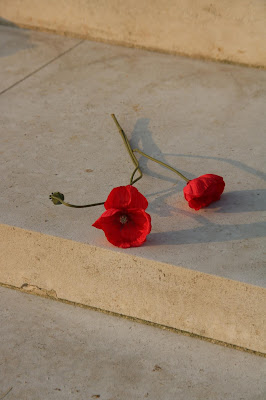p. Today was Monday- 1st of April, Day four of the travels. So we wanted to go to the furthest point for the trip.
Mont St Michael.
It was early int he morning and the sun was still coming up.
The archway his on it.
"1066: NOS A GULIELMO VICTI VICTORIS PATRIAM LIBERAVIMUS"
it is a reference to William the Conqueror and the Invasion of England in 1066: NOS A GULIELMO VICTI VICTORIS PATRIAM LIBERAVIMUS. The translation reads: "We, once conquered by William, have now set free the Conqueror's native land."
The cross was symbolic of the those buried there
We laid two Oppies we found by the road.
Then we hit the road for the place we wanted to visit today.
MONT ST MICHAEL
The island Abbey is on every tourist Boucher to see.
When we got there, we found the va=car park is still 7 Km's away. so you have a choice of Horse or Bus
We chose Horse
The Belgium horses pulling the wagon were slow but beautiful.
The Horses were obviously very well kept
and knew what the routine was.
It took at 20 Minutes by horse wagon to get to Island.
It would get gradually bigger as we traveled close to it.
Once there it was bigger then the photos make out.
It is also a lot steeper than the make out.
The street leading the top was full
of tourist shop and Food places.
Jennifer was set for the climb.
There was also lots of tourists
and this is the quiet season.
In the street was special Statues of Saints
The street got very tight and
squeezed the tourist often like this one.
We decided to do the Museum route to the top.
This was a short cut up them the house
that had been converted into Museums.
It only cost 6 Euro each but was
worth it as it missed the crowds.
We got to go into a knight home,
who when he came back became a merchant.
Furniture and large items were built
within the room as the doors were very small.
Even this way there was a lot of Stairs to climb.
Jennifer was losing her energy fast.
This is a lock box with 4 locks.
All had to be unlocked before it would open.
we saw how the townspeople would live in the middle ages.
once outside. we came across Atlantic seagulls
that was ready to eat anything they thought was food.
The goal was still above us, so we kept on climbing.
It was an easy target
We entered the abbey by these steps.
Called the pilgrim crawls
No one today was on the hands and knees crawling.
There were plenty of them.
Once at the top. you could look back at the steps and say " I made it"
and the view was great from the top as well.
it showed us we had climbed a long way.
So in we went.
To find that the Abbey is not a single large room
But Many large rooms, and a maze to find them all
The main abbey is only recent, built in the 1700s
The cloister gardens are 1400's
The main dining hall was chapel for
300 hundred years until the 1700s
Numerous small chapels were attached.
This chapel had its own cloister garden.
We found the wheelhouse which
how they bought everything up,
water food supplies and building supplies
Underneath was all the halls used
for living in and storing goods.
And the Dinning hall/kitchen was immense.
The fireplaces were
big enough to park a car.
Once outside we got a
better view of the complex.
So it was back
down again
we found the morning
tourist were gone.
almost totally.
So for some reason Jennifer
wanted to walk back.
It was strange to say goodbye to
a little gem on the Tourist Trail.
Once back in Bayeux,
we explored the town some more
into the back streets
Before finding the little treasure of a restaurant
we had found in the back streets.
This restaurant was a wonderful little French restaurant that
lived up to the French
experience perfectly.
experience perfectly.

















































